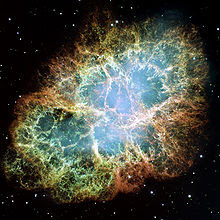Supernova is a stellar explosion that is more vital than Nova. Supernova (plural) are extremely luminous and cause an explosion of radiation that excels in many cases, for a brief period the entire galaxy before fading from view over several weeks or months. During this short interval of the supernova can radiate as much energy as is expected, emitted from the sun for more than the entire period of her life.
Explosion expels much or all of the material the star at the speed of up to 30,000 km (10% of the speed of light), and driving a shock wave in the interstellar medium surrounding it. This shock wave sweeps up expanding shell of gas and dust called a supernova remnants.
Nova (novae combination) means "new" in Latin, in reference to what appears to be the new star shines very bright in the celestial sphere; the prefix "super"
distinguishes from exploding stars novae normal, which also includes an increase in the brightness of a star, albeit highly less, through a different mechanism. The word coined by supernova astrophysics and the Swiss astronomer Fritz Zwicky, and was first used in print in 1926.
Several types of supernovae exist. And can show types I and II in one of two ways, either by turning off or suddenly turning on the production of energy through nuclear fusion. After a huge nucleus of an aging star stops generating energy from nuclear fusion, it may be subject to sudden gravitational collapse in neutron star or black hole, releasing gravitational potential energy that heats and expels the outer layers of the star.
Instead, a white dwarf star may accumulate sufficient material from the excellent companion (either through the accumulation or through merger) to raise the core temperature enough to ignite the integration of carbon, at which point it is subject to runaway nuclear fusion, and totally disabled. I went stellar cores, which furnaces permanently collapse when their masses exceed the Chandrasekhar limit, while accreting white dwarfs ignite as they approach this limit (about 1.38 times the mass of the sun).
White dwarfs are also subject to a different type much smaller than the thermonuclear explosion fueled by hydrogen on their surface called Nova. Solitary star with a mass below approximately 9 solar masses, like the sun, and turn into white dwarfs without ever becoming supernovae.
Although he did not notice any supernova in the Milky Way since 1604, the remnants of supernova event indicates an average occurs once about every 50 years in the Milky Way. It plays a major role in enriching the interstellar center with the highest elements of destruction.
Moreover, can the shock waves of expanding supernova explosions, the formation of new stars.
Explosion expels much or all of the material the star at the speed of up to 30,000 km (10% of the speed of light), and driving a shock wave in the interstellar medium surrounding it. This shock wave sweeps up expanding shell of gas and dust called a supernova remnants.
Nova (novae combination) means "new" in Latin, in reference to what appears to be the new star shines very bright in the celestial sphere; the prefix "super"
distinguishes from exploding stars novae normal, which also includes an increase in the brightness of a star, albeit highly less, through a different mechanism. The word coined by supernova astrophysics and the Swiss astronomer Fritz Zwicky, and was first used in print in 1926.
Several types of supernovae exist. And can show types I and II in one of two ways, either by turning off or suddenly turning on the production of energy through nuclear fusion. After a huge nucleus of an aging star stops generating energy from nuclear fusion, it may be subject to sudden gravitational collapse in neutron star or black hole, releasing gravitational potential energy that heats and expels the outer layers of the star.
Instead, a white dwarf star may accumulate sufficient material from the excellent companion (either through the accumulation or through merger) to raise the core temperature enough to ignite the integration of carbon, at which point it is subject to runaway nuclear fusion, and totally disabled. I went stellar cores, which furnaces permanently collapse when their masses exceed the Chandrasekhar limit, while accreting white dwarfs ignite as they approach this limit (about 1.38 times the mass of the sun).
White dwarfs are also subject to a different type much smaller than the thermonuclear explosion fueled by hydrogen on their surface called Nova. Solitary star with a mass below approximately 9 solar masses, like the sun, and turn into white dwarfs without ever becoming supernovae.
Although he did not notice any supernova in the Milky Way since 1604, the remnants of supernova event indicates an average occurs once about every 50 years in the Milky Way. It plays a major role in enriching the interstellar center with the highest elements of destruction.
Moreover, can the shock waves of expanding supernova explosions, the formation of new stars.







